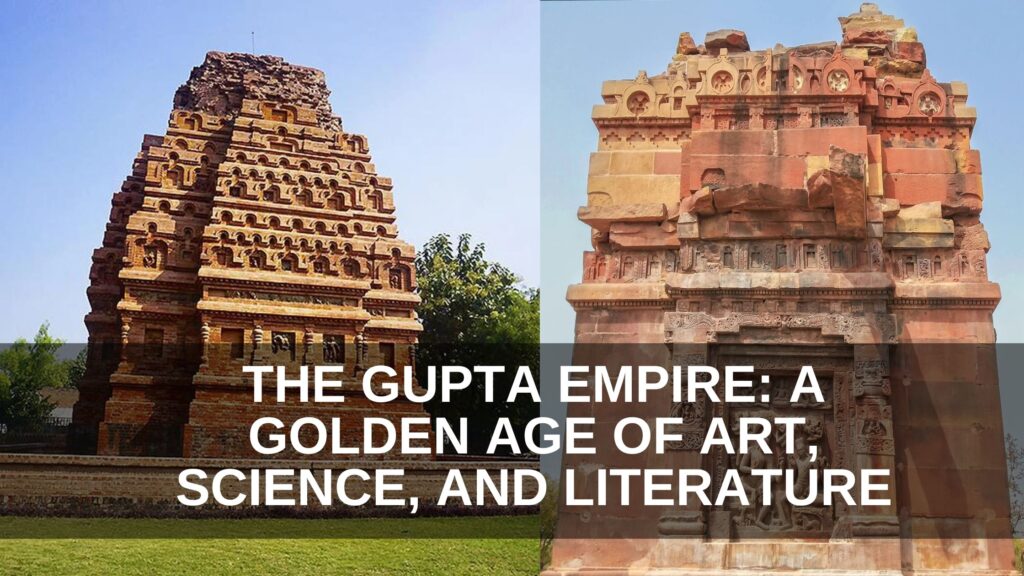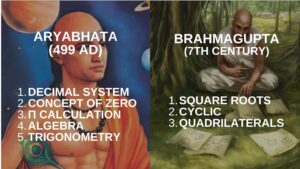The Gupta Age (circa 4th to 6th century CE) is often regarded as a golden age in Indian history, marked by significant advancements in economy, literature, science, mathematics, astronomy, and art. However, while the period was a high point for cultural and intellectual pursuits, it was not a golden age for all, particularly for untouchables, slaves, and women.
In this blog, we will explore the key aspects of Gupta society beyond its economy, focusing on its contributions to art, architecture, literature, science, and social structure.
Art and Architecture
The Gupta reign heralded the golden era of Indian temple architecture. Other artistic expressions, including painting and sculpture, also flourished during this period.
Download Satavahana Dynasty
Temples and Architectural Styles
The Gupta period saw the rise of the Nagara style of temple architecture. The Dashavatara Vishnu temple at Deogarh is the earliest example of the Panchayatana style of temple construction, featuring a main shrine surrounded by four subsidiary shrines. Some key features of Gupta temples include:
- A square sanctum (garbhagriha) with a pillared entrance
- Elaborate decorative sculptures adorning temple walls
Major Temples of the Gupta Period:
| Temple | Location |
|---|---|
| Shiva Temple | Bhumara, MP |
| Parvati Temple | Nachna Kuthara, MP |
| Dashavatara Temple | Deogarh, UP |
| Brick Temple | Bhitargaon, UP |
| Kankali Devi Temple | Tigawa, MP |
Paintings
The Gupta period saw exquisite cave paintings, particularly in Bagh and Ajanta caves:
- Bagh Cave Paintings (MP): Depict portraits of Buddha and Jataka stories.
- Ajanta Cave Paintings (Maharashtra):
-
- Cave 16: Scenes of Buddha’s renunciation.
- Cave 17: Various Jataka tales portraying Buddha’s previous lives.
Sculptures
A distinct Sarnath school of sculpture developed, characterized by smooth, cream-colored sandstone sculptures. Notable features include:
- Draped figures with no nudity
- Decorative halos around Buddha’s head
- Continued advancements in metal sculpting, exemplified by the Sultanganj Buddha cast in copper.
Inscriptions and Epigraphy
Gupta inscriptions, written in Gupta Brahmi script, provide valuable historical records. Sanskrit became the dominant language of official inscriptions, replacing vernacular dialects like Pali and Prakrit.
Important Inscriptions:
- Prayag-Prashasti Inscription: Engraved on Ashoka’s Allahabad Pillar by Harisena, court poet of Samudragupta (335–380 AD). It describes Samudragupta’s military conquests.
- Iron Pillar (Mehrauli, Delhi): Constructed by Chandragupta II (380–412 AD), this pillar has not rusted for over 1600 years due to advanced metallurgy techniques.
- Eran Stone Pillar Inscriptions (MP):
-
- First inscription mentioning the practice of Sati.
- Decimal numeral script found in Samudragupta’s Eran inscription.
- Toramana’s inscription on a boar sculpture signifies Alchon Huns’ control over Malwa.
Scientific Advancements During the Gupta Empire
The Gupta era was a time of remarkable scientific discoveries, many of which later influenced European and Arab scholars.
Mathematics
| Author | Work | Contributions |
| Aryabhata | Aryabhatiya (499 AD) | Decimal system, concept of zero, π calculation, algebra, and trigonometry. |
| Brahmagupta | Brahmasphuta Siddhanta (7th century) | Square roots, cyclic quadrilaterals. |
| Suryasiddhanta | Suryasiddhanta (4th century) | Trigonometry, use of sine and tangent. |
Astronomy and Astrology
- Varahmihira, the Father of Indian Astronomy, wrote:
- Pancha Siddhantika: Compilation of five astronomical treatises.
- Brihat Samhita: Discusses planetary movements, eclipses, and weather predictions.
- Laghu & Brihaj Jataka: Works on horoscopy and astrology.
Medicine and Metallurgy
- Charaka and Sushruta’s medical texts were summarized in Ashtanga Sangraha by Vagbhatta I.
- Dhanvantari, a renowned physician, wrote Dhanvantarisamhita.
- Metallurgy: The Iron Pillar of Mehrauli demonstrates advanced rust-resistant iron technology.
Literary Achievements
Epics and Religious Texts
- Ramayana and Mahabharata reached their final form.
- Puranas, such as the Vishnu Purana, mention Gupta rulers.
Sanskrit Drama and Poetry
- Kalidasa (court poet of Chandragupta II, Vikramaditya) wrote:
- Plays: Malavikaagnimitram, Abhijnana Shakuntalam, Vikramorvashiyam.
- Epics: Raghuvamsa, Kumarasambhava.
- Poetry: Meghadoot, Ritusamhara.
- Vishakhadatta wrote historical dramas:
- Mudra Rakshasa (Rise of Chandragupta Maurya)
- Devi Chandraguptam (Life of Gupta kings Ramagupta & Chandragupta II).
Accounts of Fa-Hein
Chinese Buddhist monk Fa-Hein visited India during Chandragupta II’s reign and documented Indian society and Buddhism.
Gupta Society and Social Structure
Position of Women
- Marriage practices: Polygamy, child marriage, and endogamy were common.
- Women’s rights: Upper-caste women faced restrictions, while lower-caste women had more economic freedom.
- First evidence of Sati: Recorded in the Eran Pillar Inscription (MP).
Caste System
- Emergence of Jatis (sub-castes) due to new occupations.
- Guilds (Shrenis) regulated trade and profession-based communities.
- Untouchability: Chandala communities faced severe discrimination, living outside villages.
Download Megaliths Notes
Religion
- Hinduism: Strengthened through temple grants and Brahmanical traditions.
- Buddhism: Declined as royal patronage shifted towards Hinduism; Mahayana Buddhism thrived.
- Jainism: Migrated to western and central India, where it remained influential.
- Tantric Cults: Emerged, associating with goddesses Kali, Parvati, and Tara.
The Gupta Empire was a transformative period in Indian history, setting the foundation for future advancements in art, science, literature, and culture. While it was a golden age for intellectual and artistic pursuits, social inequalities remained rigid, affecting women, lower castes, and untouchables. Nevertheless, its enduring legacy continues to inspire scholars and historians today.



